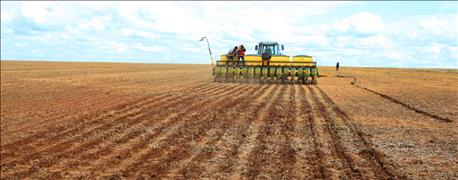
Have your planter ready? The Brazilians do. Many of them started planting soybeans by mid-September, a time of year that promises decent rainfall in the Southern Hemisphere. This fall it's a promise overshadowed by something most North American farmers will face just six months from now: crop budget sticker shock.
Until recently Brazilian farmers were protected from the worst effects of the worldwide downturn in commodity prices. Sure, they made less money producing commodities, but the U.S. dollar's second wind (or the Brazilian real's listlessness) cushioned what was a harder blow for U.S. farmers.

A Brazilian farmer begins planting in Nova Mutum, Mato Grosso. Photo by Lenine Martins/Secom-MT
But today the Brazilians are going over crop budgets and shaking their heads at steep input costs despite a mid-July uptick in grain prices brought about by downpours in the U.S. Even as waters receded and Midwest crops recovered, the dollar continued to soar. One dollar bought R$3.12 in mid-July and R$3.46 by early September, sending inputs costs through the roof. A weaker currency makes imports more expensive, and some 70% of Brazil's fertilizers are imported.
Related: Brazilian consultant sees bigger soy crop coming
It's enough to make a Brazilian producer pine for those heady days of harvest, when a climbing dollar shielded him from some of the drop in bean prices. Now the piper is at the door, demanding to be paid.
As things get more expensive while the dollar climbs, crop loans at government-subsidized interest rates are going to be not only scarcer, but also costlier this season. In ever-expanding Brazil, higher costs don't necessarily lead to fewer planted acres — but early predictions have the coming crop expanding at only about 1% for 2015-16, compared to the nearly double-digit increases in the season just ended.
~~~PAGE_BREAK_HERE~~~
Fewer acres – but when?
In a down cycle, low prices should, in effect, cure low prices by discouraging production. But there appears to be a standoff developing, and neither Brazilian nor American farmers appear to be letting up on the production gas pedal.
By mid-July, one consultancy estimated Brazil's 2015-16 bean crop at 97 million to 98 million tonnes, up anywhere from less than 1% to 2% from 2014-15's 96.2 million. Analyst Safras & Mercado, meanwhile, puts the country's coming bean crop at a whopping 99.8 million tonnes, up nearly 4 points from last season.
Either way, nobody was looking for production to drop in response to the new and less-than-pleasant reality of lower commodity prices.
Meanwhile, a recent Farm Futures survey shows North American farmers aren't discouraged much by low grain prices either. The survey showed farmers ready to plant 89.65 million acres of corn in 2016, up about 1% from 2015. Growth in soybean seedings could be even greater. Farmers reported they wanted to plant 86.32 million acres, a record if achieved. That would be 2.4% higher than the estimate USDA made in August after resurveying farmers in areas hit by heavy rains this spring.
Let's face it: Low prices are bad for all producers, everywhere. But who is better situated to deal with that situation, and how does it change what they do?
So does planting more mean the Brazilians have adapted a sort of evolutionary advantage that makes them less vulnerable than their U.S. counterparts to chronic lower prices? Well, yes and no.
Purdue economist Michael Langemeier notes there are plenty of places in Brazil that can squeeze out two crops a year — early beans followed by corn and lots of prayers that the rains don't stop before that corn is safely through pollination.
"We've got the edge in corn production, but they may have an advantage in soy," says Langemeier. "It's a real challenge to compete [cost-wise] with Brazil on soy."
~~~PAGE_BREAK_HERE~~~
Langemeier recently returned from a trip to Brazil where he participated in an Agri-benchmark conference put on by a worldwide group of ag economists with the aim of analyzing world ag economic data in standardized terms. Local conditions are different enough that it's hard to compare an irrigated Cornhusker farm and a flooded Hoosier operation. Now imagine comparing U.S. production to Brazilian. The economists did their best to compare apples to apples, but it wasn't easy.
For example, there has been little indication of switching crops after crop prices began to swoon earlier this year. "So far, I can't see any big acreage cutbacks in soy acres happening down there for the 2015-16 season," says Farm Futures Senior Grain Market Analyst Bryce Knorr. "Indications are that they're booking forward sales more heavily than normal, which means they are locking production in."
By mid-July, producers in Mato Grosso had sold about 20% of their 2015-16 crop, versus the usual 13% for that time of year. And the pace picked up in August, with about 30% of Brazil's 2014-15 bean crop having already been sold by Sept. 9.
Tomorrow: We look at which country has the edge in finance, land and production costs.
About the Author(s)
You May Also Like






